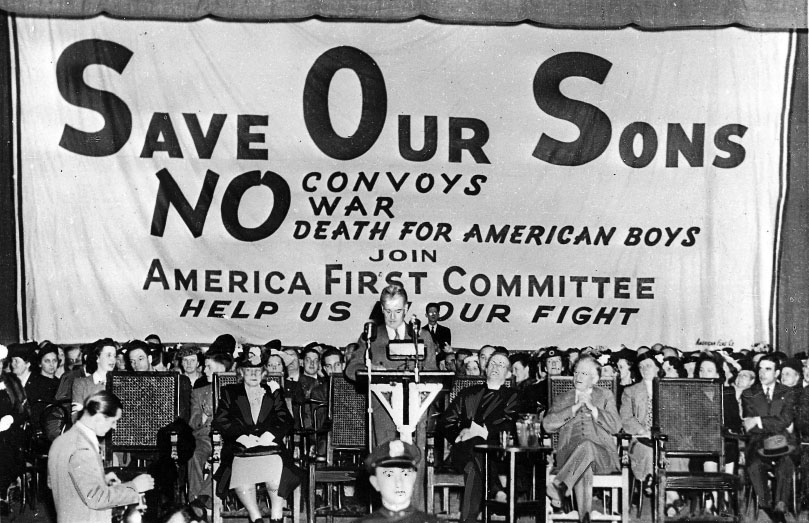Exploring American Histories: Printed Page 724
Exploring American Histories, Value Edition: Printed Page 595
The Challenge to Isolationism
As Europe drifted toward war, public opinion polls revealed that most Americans wanted to stay out of any European conflict. The president, however, thought it likely that the United States would eventually need to assist the Western democracies. Given the United States’ economic dominance in the world and its dependence on international commerce, Roosevelt feared that Germany and Italy threatened a stable world order. Still, Roosevelt had to tread lightly in the face of the Neutrality Acts that Congress had passed between 1935 and 1937 and overwhelming public opposition to American involvement in Europe.
Germany’s aggression in Europe eventually led to full-scale war. When Germany invaded Poland in September 1939, Britain and France declared war on Germany and Italy. Just before the invasion, the Soviet Union had signed a nonaggression agreement with Germany, which carved up Poland between the two nations and permitted the USSR to occupy the neighboring Baltic states of Latvia, Lithuania, and Estonia. Soviet leader Joseph Stalin had few illusions about Hitler’s ultimate design on his own nation, but he concluded that by signing this pact he could secure his country’s western borders and buy additional time. (In June 1941, the Germans broke the pact and invaded the Soviet Union.)
Roosevelt responded to the outbreak of war by reaffirming U.S. neutrality. Unlike Woodrow Wilson, however, he recognized that this position would be hard to maintain, asserting, “This nation will remain a neutral nation, but I cannot ask that every American remain neutral in thought as well,” and “Even a neutral cannot be asked to close his mind or close his conscience.” Despite his sympathy for the Allies, which most Americans had come to share, the president stated his hope that the United States could stay out of the war: “Let no man or woman thoughtlessly or falsely talk of Americans sending its armies to European fields.”
With the United States on the sidelines, German forces marched toward victory. By the spring of 1940, German armies had launched a blitzkrieg (lightning war) across Europe, defeating and occupying Denmark, Norway, the Netherlands, Belgium, and Luxembourg. The greatest shock occurred in June 1940 when France fell to the German onslaught and Nazi troops marched into Paris. Britain now stood virtually alone, and its position seemed tenuous. The British had barely succeeded in evacuating their forces from France by sea when the German Luftwaffe (air force) began a relentless bombing campaign on London and other targets in the Battle of Britain.
With German victories mounting, committed opponents of American involvement in foreign wars organized the America First Committee. Gerald Nye helped found the organization, which attracted New Deal critics such as Father Charles Coughlin and William Lemke; business leaders who opposed Roosevelt, such as Sears, Roebuck head Robert Wood; and aviation hero Charles A. Lindbergh, who admired what Hitler had accomplished in building up the Luftwaffe. America First tapped into the feeling of isolationism and concern among a diverse group of Americans who did not want to get dragged into another foreign war.
The surrender of France and the Battle of Britain drastically changed Americans’ attitude toward entering the war. Before Germany invaded France, 82 percent of Americans thought that the United States should not aid the Allies. After France’s defeat, in a complete turnaround, some 80 percent of Americans favored assisting Great Britain in some way, though most expected that this aid would lead to further U.S. involvement. However, four out of five Americans polled opposed immediate entry into the war. As a result, the politically astute Roosevelt portrayed all U.S. assistance to Britain as a way to prevent American military intervention by allowing Great Britain to defeat the Germans on its own.
From September 1940 to November 1941, the Roosevelt administration helped Britain in any way it could, short of going to war against Germany. On September 2, 1940, the president sent fifty obsolete destroyers to the British in return for leases on British naval bases in Newfoundland, Bermuda, and the British West Indies. These aging warships did not have much military value, but they provided a great morale boost to the British, who were being pounded by German air attacks. Two weeks later, on September 16, Roosevelt persuaded Congress to pass the Selective Service Act, the first peacetime military draft in U.S. history, which quickly registered more than 16 million men.

This political maneuvering came as Roosevelt campaigned for an unprecedented third term in 1940. He defeated the Republican Wendell Willkie, a Wall Street lawyer who shared Roosevelt’s anti-isolationist views. However, both candidates accommodated voters’ desire to stay out of the European war, and Roosevelt went so far as to promise American parents: “Your boys are not going to be sent into any foreign war.”
Roosevelt’s campaign promises did not halt the march toward war. Roosevelt succeeded in pushing Congress to pass the Lend-Lease Act in March 1941. With Britain running out of money and its shipping devastated by German submarines, this measure circumvented the cash-and-carry provisions of the Neutrality Acts. The United States would lend or lease equipment, but no one expected the recipients to return the used weapons and other commodities. As one critic of the act declared, “Lending war equipment is a good deal like chewing gum, you don’t really want it back!” To protect British ships carrying American supplies, the president extended naval and air patrols in the North Atlantic. In response, German submarines began sinking U.S. ships. By May 1941, Germany and the United States were engaged in an undeclared naval war.